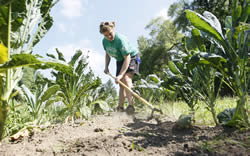No matter if the weather is cool or hot or wet or dry, gardeners must do battle with weeds. Despite having a number of weapons to fight this battle, this year the weeds have won the war at my place. Between torrential rains, heat waves and ravenous mosquitoes, I must confess to nearly giving up. But I have renewed my efforts by putting myself on a weeding exercise schedule.
That’s right, weeding is good exercise! According to the AARP activity calculator, a 175-pound person can burn around 180 calories per half hour through activities such as raking, planting, weeding and pruning. I think if I convince myself to do just 30 minutes of weeding a day, maybe I can at least make a slight dent in preventing new weeds for next year. And maybe earn an extra cookie in my lunchbox!
The best weapons for the home garden and landscape include tools such as the hoe and rototiller. There are quite a few different designs for weeding tools, including different handle lengths, pointed arrow-shaped blades, winged blades and scuffle hoes, which have a twin-blade action. For larger areas, shallow cultivation with a rototiller a few times during the season can do wonders.
Mulching around plants will go a long way toward reducing the ability of weeds to take over. Organic mulches tend to cool the soil, as well as conserve soil moisture and reduce weed germination. Materials such as chipped or shredded bark, straw, hay, grass clippings or pine needles should be applied 2-4 inches deep and replenished as needed. Plastic mulch tends to warm the soil and is best used on warm-season vegetables, such as tomatoes, melons, squash and peppers. If soil gets too hot in mid-summer, you might want to put a shallow layer of organic mulch on top of the plastic.
Don’t underestimate the power of your bare hands (well, make that gloved-hands)! Young weeds can be very easy to pull, especially during or just after a rain. You want to prevent the weeds from going to seed, as that will bring many more future battles. For example, a single dandelion plant can produce 15,000 seeds in one year, and each seed is capable of surviving for up to 6 years in the soil. Each purslane plant can produce more than 52,000 seeds, and these seeds can survive up to 30 years in the soil. So, it is in your best interest to stay ahead of the weeds!
Although a dizzying number of herbicides (pesticides designed to kill plants) approved by the EPA are available, only a relatively limited number of them come in small homeowner-sized packages. Generally speaking, herbicides are low in risk to people and animals when they are used according to the label. But there is a risk of doing damage to the very plants you are trying to protect.
There are different types of herbicides, based on how they perform. Some must be applied before the weeds emerge; others can be applied after they have already started growing. Some have a greater tendency to volatilize and drift from their intended target.
Some herbicide products come ready to use in a convenient, trigger-spray bottle, while others have to be mixed with water. There are also some specialized application products that can help minimize risk to desirable plants, such as wick and wand applicators that allow you to place the herbicide directly on the intended victim.
It is easy to see where the home gardener can end up causing unintended damage to other plants. If you choose to use an herbicide, be sure to read and follow all of the label instructions before you apply. And, if you use sprayers and other equipment for herbicide application, make sure you label them for that use and have a different set to use for other types of pesticides.
For more information on weed control in the yard and garden, take a look at Purdue Extension publication HO-217 http://www.hort.purdue.edu/ext/HO-217.pdf.
